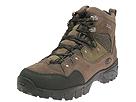
Hiking Boot Guide
Buying Good Hiking Boots

 |
Hiking Boot Guide |
 |
| Home > Hiking Gear > Hiking Boots > Buying Good Hiking Boots | Search Site |
Hiking Boots
Hiking Gear
|
Tips for Buying Good Hiking Boots
|
 |
| An example of a good hiking boot for day hiking - not too too or heavy, but solid in ankle support |
There are, quite literally, a ton of hiking boots on the market today. Unfortunately, many of them are masquerading as a quality product - and will only show their true identities while out on the trail, as the boot begins to leak water, cause some nasty blisters or begins to pull apart by the seams.
So, to help the wary, here's some things to keep in mind when hunting around for a hiking boot.
Here's some boot fitting tips that you will want to keep in mind.
Socks - Hiking boots are meant to be worn over hiking socks, not your general cotton sock. Hiking socks provide significant padding on them, allowing for a more comfortable and cushiony walk. Hiking socks also take perspiration off your feet, helping your feet to stay dry. As such, make sure any boot you buy will properly fit over the socks you buy. Don't try out hiking boots in cotton socks, as the boots may seem more snug once you try them on with a hiking sock (Smartwool Socks are my recommended choice of sock for hiking, if it matters any).
Moreover, it is absolutely crucial to actually wear hiking socks while out on the trail! Not wearing a hiking sock is the #1 way to cause blisters (how to prevent blisters). So unless you enjoy blisters, keep the cotton socks at home when hiking.
Test Walk Your Boots - Don't be bashful about walking around in your hiking boots right after purchase. Virtually all online merchants (unlike most brick and mortar stores, for whatever reason) allow returns of hiking boots if they aren't obviously beat up. Walk around the block for a bit to make sure that your feet aren't moving in the boot. If you feel your foot moving around on a simple walk around the block, particularly around the ankle, you know for a fact that as soon as you hit the trail blisters will start occurring. By the same token, make sure that your toes aren't bashing into the front of the boot. Test this by walking down a steep hill - even a small hill will do just fine for this test.
Comfort - Comfort is everything in a hiking boot. If the boot is horribly uncomfortable right out of the box, it's unlikely to get much better over time. While hiking boots do stretch out, if the boot is painfully pinching in places than it is almost surely always going to be painful. This is a good reason to buy boots at Zappos - you can return the boot with no haggling, no return cost nor any questions asked.
Waterproof - This is just my own recommendation, but any hiking boot you buy should be either waterproof right out of the box (such as Gore-Tex) or made from materials (such as leather) that can be made waterproof with the applications of various topical gels and compounds. On the trail, you're likely to end up crossing streams, walk through puddles and in general get your boots wet. Since wet feet lead to blisters, cold feet and general discomfort, it only makes sense to keep your feet dry by having waterproof boots.
|
Copyright 2002-2018 |
![]()
| Montana Web Cams | Montana Information | Fly Fishing Gear | Fishing Boats | About | Contact Us | Advertising Information | Privacy Policy |